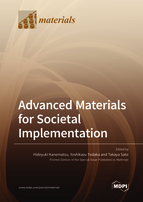Advanced Materials for Societal Implementation
A special issue of Materials (ISSN 1996-1944).
Deadline for manuscript submissions: closed (30 April 2022) | Viewed by 46171
Special Issue Editors
Interests: biofilm engineering; environmental friendly surface engineering; creative engineering
Special Issues, Collections and Topics in MDPI journals
Interests: lattice defect; grain refinement; severe plastic deformation
Interests: polymer brush; ionic liquids; polymer electrolyte; super capacitor; fibers; gels; ion gels; gel electrolyte; soft tribology material
Special Issues, Collections and Topics in MDPI journals
Special Issue Information
Dear Colleagues,
Materials science is the fundamental base for all engineering disciplines. From mechanical engineering to medical science, electrical engineering, and chemical engineering, to information technology, every discipline requires knowledge and information about materials science and engineering. Actually, we can say everything is material. In Japan, the National Institute of Technology (KOSEN), one of the biggest higher education organizations, started an extensive research project throughout the country. NIT KOSEN was the first established network in the islands of Japan. The 51 colleges of KOSEN are established everywhere in Japan, and they were consolidated into one big organization almost 17 years ago. Now, it is actively pursuing an industrial–academia partnership in order to carry out joint experiments, to develop collaboration products, and also to cultivate young engineers in the future through these joint projects. KOSEN started their new nationwide research project called GEAR 5.0 in May 2020. This basically a research and education project to train young students heading into industrial fields in KOSEN, so that they can adjust themselves to a new smart society (Society 5.0 in Japan or Industry 4.0 in Germany) and can actively make significant contributions to these societies. In this large national project for KOSEN, certain main engineering disciplines were chosen and their research hubs were established in particular areas. Currently, research activities are taking place to boost industrial and economic situations. Materials science and engineering are some of the key disciplines selected for the GEAR 5.0 project. In this Special Issue, we broadly call for papers relating to materials science and engineering. As mentioned above, topics of interest are not restricted to basic and conventional topics for materials science and engineering. We instead welcome papers dealing with versatile applications of materials science and engineering in various industrial fields. Originally, many papers targeted for this Special Issue constituted the core for the international conference of ISATE 2021 held in Finland. However, nowadays, because of COVID-19, international conferences are challenging to attend, and instead, we are focused on national conferences.
The International Symposium on Advances in Technology Education (ISATE) 2021 will be held in Turku, Finland, on 17–20 August 2021, and will provide special symposiums on “Health Technology and Medical Engineering” and “Functional Engineering Materials” in order to publish the research achievements of the GEAR5.0 project carried out by the National Institute of Technology, Japan. This Special Issue will be published as a collection of some of the outstanding studies published at ISATE 2021. However, more than that, we want to discover new advanced materials from scientists from all over the world.
In addition, we would like to formalize new and innovative technological and scientific knowledge through competitive environments. Therefore, we are now calling for papers on materials science and engineering, particularly on the practical application. Please do not hesitate to submit your valuable ideas as potential papers for this Special Issue.
We look forward to your submissions.
Prof. Hideyuki Kanematsu
Prof. Yoshikazu Todaka
Prof. Takaya Sato
Guest Editors
Manuscript Submission Information
Manuscripts should be submitted online at www.mdpi.com by registering and logging in to this website. Once you are registered, click here to go to the submission form. Manuscripts can be submitted until the deadline. All submissions that pass pre-check are peer-reviewed. Accepted papers will be published continuously in the journal (as soon as accepted) and will be listed together on the special issue website. Research articles, review articles as well as short communications are invited. For planned papers, a title and short abstract (about 100 words) can be sent to the Editorial Office for announcement on this website.
Submitted manuscripts should not have been published previously, nor be under consideration for publication elsewhere (except conference proceedings papers). All manuscripts are thoroughly refereed through a single-blind peer-review process. A guide for authors and other relevant information for submission of manuscripts is available on the Instructions for Authors page. Materials is an international peer-reviewed open access semimonthly journal published by MDPI.
Please visit the Instructions for Authors page before submitting a manuscript. The Article Processing Charge (APC) for publication in this open access journal is 2600 CHF (Swiss Francs). Submitted papers should be well formatted and use good English. Authors may use MDPI's English editing service prior to publication or during author revisions.
Keywords
- mechanical materials
- electronic materials
- polymer
- ceramics
- materials informatics
- environmental-friendly materials
- materials for buildings
- antibacterial, antiviral and anti-fouling materials
- advanced materials









